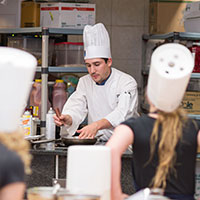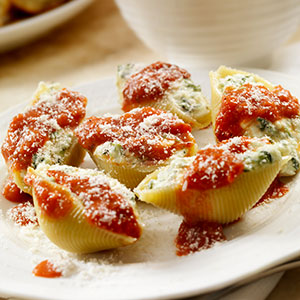Quality time in the kitchen makes for delicious memories
Thinking about kids' relationships with cooking and eating raises memories for Daniel Brasileiro (Culinary Arts ’06). One is being stuck at the dinner table, alone long after the meal, refusing to clean his plate. At times like that, eating was a chore.
“I don’t want that engrained into kids,” says the lab tech with NAIT’s Culinary Arts program.
The better memory is the large Sunday gatherings revolving around food. He played a part by helping his grandma make “Portuguese perogies,” he says, and chopping vegetables and setting the table.
That’s what ultimately shaped his own relationship with food. “For me, cooking is fun.”
As the instructor for NAIT’s Mini-chefs summer camps, designed to get children 8 to 16 years old cooking,  Brasileiro wants kids to have similar positive feelings about making and eating food. It seems his efforts work. “I haven’t seen one kid not eat something we’ve made,” he says. Rather than cajoling them to clean their plates, “usually you have to tell them to slow down.”
Brasileiro wants kids to have similar positive feelings about making and eating food. It seems his efforts work. “I haven’t seen one kid not eat something we’ve made,” he says. Rather than cajoling them to clean their plates, “usually you have to tell them to slow down.”
We asked him why his Mini-chefs become more accustomed to the kitchen – making everything from homemade pasta to sliders to salsa – and happier about eating what comes out of it.
The good kind of picky
Veggies can be tough, cooked or raw. The trick is not to turn them into a necessary evil. “Once you’re forcing kids to eat something, they get this preconception that it’s bad,” says Brasileiro. Instead, he gives them control. Nearly every dish they make must contain a vegetable. Which one is up to the kids – let them say no to some things but yes to others, he advises.
Knowledge is power
Trust kids in the kitchen, suggests Brasileiro. After explaining the basics – like what baking soda does, how yeast works, and so on – he lets them take ownership of their cooking projects.
That means ensuring ingredients are clearly labelled so they can help themselves. It also means being present but not looming, letting kids solve problems among themselves (at home, siblings might sort things out).
 Revise the recipe
Revise the recipe
Brasileiro knows kids need to understand how to read a recipe. He also knows they need to be allowed to deviate. “It’s not set in stone,” he says. Though he makes sure that a Caesar salad doesn’t turn into a Cobb, he wants kids to eat it in the end. “We’re giving them individual responsibility to make it the way they like it.”
This can also reduce waste. When a recipe calls for cheddar but packages of mozzarella and parmesan need using up, let young chefs know it’s fine to be flexible. “If it’s already open, why open up something else?”
Accept the mess
Parents may have trouble with the idea of letting the chips – and the more wholesome parts of a meal – fall where they may. Try to stay calm until it’s time to for the kids to clean up. “Let them have fun,” says Brasileiro. “If they make a mess it’s OK.” It means they’re enjoying themselves and the process.
Besides, there’s a way to get kids to police themselves in the kitchen, he adds. If you limit their ingredients (like any real-life kitchen), messy chefs will naturally learn to keep tidy. Try a simple reminder, says Brasileiro. The bigger the mess, “the less for you to eat.”
 Recipe: Stuffed Ricotta Shells
Recipe: Stuffed Ricotta Shells
Yield: 3 shells
There may be spinach in it, but with the Mini-chefs doing the cooking weren't bothered, says Brasileiro of this simple pasta dish. “They all devoured it.” Try it in your kitchen, where you can get the kids set up with ingredients and handle the frying and the oven for them.
Ingredients
- 3 jumbo pasta shells (cook a couple of extra shells to allow for a few breaking while the pasta cooks)
- 5 ml (1 tsp) olive oil
- 5 ml (1 tsp) fresh garlic, minced
- 250 ml (1 cup, packed) fresh spinach leaves, roughly chopped
- 60 ml (2 oz) ricotta cheese
- 15 ml (1 tbsp) grated Parmesan cheese, plus more for serving
- 15 ml (1 tbsp) fresh basil, finely chopped
- 5 ml (1 tsp) kosher salt
- 2ml (1/2 tsp) freshly ground black pepper
- 310 ml (1 1/4) cups marinara sauce
Preparation
- Preheat the oven to 375 F (190 C). Cook the pasta al dente, according to package directions. Drain and set aside.
- Meanwhile, heat the olive oil in a large skillet over medium high heat. When the oil begins to shimmer, add the garlic and cook until it begins to brown, about a minute or 2. Add the spinach and cook, stirring occasionally, until the leaves begin to wilt but are still bright green, about 3 to 4 minutes. The spinach should be reduced by half. Remove from the heat and let cool.
- In a mixing bowl, stir together the spinach, ricotta, basil and salt and pepper until thoroughly combined. Pour 125 ml (1/2 cup) of the marinara sauce into the bottom of a shallow 8-by-8-inch baking dish. Stuff each pasta shell with a generous amount of the spinach and ricotta mixture, and place in the baking dish.
- Cover with the remaining sauce, and sprinkle parmesan cheese and bake covered with aluminum foil for 25 minutes. Remove the foil and continue baking until the top begins to brown and the sauce begins the bubble, another 10 to 15 minutes.